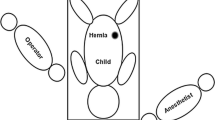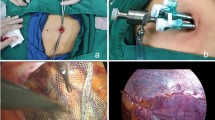Abstract
Background
Laparoscopic surgery is an alternative procedure for pediatric inguinal hernia (PIH), with a major trend toward increasing use of extracorporeal knotting and decreasing use of working ports. We report our experience with the modified single-port laparoscopic herniorrhaphy for repair of PIH and retrospectively evaluate a consecutive series of 1,107 cases in our institution.
Methods
Between February 2006 and July 2011, 1,107 children with indirect inguinal hernia were treated by laparoscopic surgery. All patients underwent high ligation surgery with a modified single-port laparoscopic technique, mainly performed by extracorporeal suturing with an ordinary taper needle (1/2 Arc 11 × 34). The clinical data were retrospectively analyzed.
Results
All surgery was successful without any serious complications. During the operations, contralateral patent processus vaginalis was found and subsequently repaired in 221 cases (20.0 %). The mean operative time was 11 (range 5–14) min in 815 cases of unilateral repair and 20 (range 14–27) min in 292 cases of bilateral repair. The mean of postoperative hospital stay was 48 (range 26–52) h. Complications occurred in seven cases (0.63 %) and were properly managed, with no major impact on outcome of the operations. There were six recurrent cases (0.54 %) in the patients who had been followed-up for 9–74 months. There was no obvious scaring visible in any patients after treatment.
Conclusions
The modified single-port laparoscopic technique for the repair of PIH is a safe and reliable procedure with minimal invasion and satisfactory outcome. It is easy to perfect and to perform and therefore is a worthy choice for PIH.







Similar content being viewed by others
References
Brandt ML (2008) Pediatric hernias. Surg Clin N Am 88:27–43
El-Gohary MA (1997) Laparoscopic ligation of inguinal hernia in girls. Pediatr Endosurg Innov Techn 1:185–187
Gorsler CM, Schier F (2003) Laparoscopic herniorrhaphy in children. Surg Endosc 17:571–573
Chan KL, Tam PKH (2004) Technical refinements in laparoscopic repair of childhood inguinal hernias. Surg Endosc 18:957–960
Becmeur F, Philippe P, Schultz AL, Moog R, Grandadam S, Lieber A, Toledano D (2004) A continuous series of 96 laparoscopic inguinal hernia repairs in children by a new technique. Surg Endosc 18:1738–1741
Yip KF, Tam PKH, Li MKW (2004) Laparoscopic flip-flap hernioplasty: an innovative technique for pediatric hernia surgery. Surg Endosc 18:1126–1127
Chan KL, Hui WC, Tam PKH (2005) Prospective, randomized, single-centre, single blind comparison of laparoscopic vs open repair of pediatric inguinal hernia. Surg Endosc 19:927–932
Schier F (2006) Laparoscopic inguinal hernia repair: a prospective personal series of 542 children. J Pediatr Surg 41:1081–1084
Zallen G, Glick PL (2007) Laparoscopic inversion and ligation inguinal hernia repair in girls. J Laparoendosc Adv Surg Technol A 17:143–145
Spurbeck WW, Prasad R, Lobe TE (2005) Two-year experience with minimally invasive herniorrhaphy in children. Surg Endosc 19:551
Shalaby RY, Fawy M, Soliman SM, Dorgham A (2006) A new simplified technique for needlescopic inguinal herniorrhaphy in children. J Pediatr Surg 41:863–867
Shalaby R, Shams AM, Mohamed S, El-Leathy M, Ibrahem M, Alsaed G (2007) Two-trocar needlescopic approach to incarcerated inguinal hernia in children. J Pediatr Surg 42:1259–1262
Harrison MR, Lee H, Albanese CT, Farmer DL (2005) Subcutaneous endoscopically assisted ligation (SEAL) of the internal ring for repair of inguinal hernias in children: a novel technique. J Pediatr Surg 40:1177–1180
Patkowski D, Czernik J, Chrzan R, Jaworski W, Apoznanski W (2006) Percutaneous internal ring suturing: a simple minimally invasive technique for inguinal hernia repair in children. J Laparoendosc Adv Surg Tech 16:513–517
Ozgediz D, Roayaie K, Lee H, Nobuhara KK, Farmer DL, Bratton B, Harrison MR (2007) Subcutaneous endoscopically assisted ligation (SEAL) of the internal ring for repair of inguinal hernias in children: report of a new technique and early results. Surg Endosc 21:1327–1331
Saranga Bharathi R, Arora M, Baskaran V (2008) How we “SEAL” the internal ring in pediatric inguinal hernias. Surg Laparosc Endosc Percutan Tech 18:192–194
Chang YT, Lee JY, Tsai CJ, Chiu WC, Chiou CS (2011) Preliminary experience of one-trocar laparoscopic herniorrhaphy in infants and children. J Laparoendosc Adv Surg Tech 21:277–282
Saranga Bharathi R, Arora M, Baskaran V (2008) Minimal access surgery of pediatric inguinal hernias: a review. Surg Endosc 22:1751–1762
Ger R (1982) The management of certain abdominal herniae by intraabdominal closure of neck of sac. Ann R Coll Surg Engl 64:342–344
Acknowledgments
The authors thank Mr. Donal I. Kirk and Mr. Wayne R. Tait for their valuable language assistance in the preparation of the manuscript.
Disclosures
Binggen Li, Xiangyang Nie, Huihua Xie, and Duhui Gong have no conflict of interest or financial affiliations to disclose.
Author information
Authors and Affiliations
Corresponding author
Additional information
Binggen Li and Xiangyang Nie contributed equally to this study.
Rights and permissions
About this article
Cite this article
Li, B., Nie, X., Xie, H. et al. Modified single-port laparoscopic herniorrhaphy for pediatric inguinal hernias: based on 1,107 cases in China. Surg Endosc 26, 3663–3668 (2012). https://doi.org/10.1007/s00464-012-2396-z
Received:
Accepted:
Published:
Issue Date:
DOI: https://doi.org/10.1007/s00464-012-2396-z




